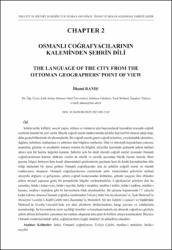Osmanlı Coğrafyacılarının Kaleminden Şehrin Dili
Künye
DANIŞ, İlhami. "Osmanlı Coğrafyacılarının Kaleminden Şehrin Dili." The City in History in Respect of Human and Space / İnsan ve Mekan Açısından Tarihte Şehir, (2021): 19-44.Özet
Şehrin tarihi, kültürü, sosyal yapısı, nüfusu ve mimarisi için başvurulacak kaynaklar arasında coğrafi
eserlerin önemli bir yeri vardır. Birçok coğrafi eserin muhtevasında şehirler hep özel bir öneme sahip olup,
daha geniş bölümlerde ele alınmışlardır. Bir coğrafi eserde genel coğrafi terimlere, yeryüzündeki denizlere,
dağlara, nehirlere, toplumlara ve şehirlere dair bilgilere rastlanılır. Dini ve mitolojik kaynakların yanısıra,
araştırma, gözlem ve seyahatler sonucu erişilen bu bilgiler, yüzyıllar içerisinde gelişerek şehrin tarihsel
süreci için bir hazine değerini kazanır. Şehirler için bu denli önemli coğrafi eserler arasında Osmanlı
coğrafyacılarının kaleme aldıkları eserler de nitelik ve nicelik açısından büyük öneme haizdir. Hem
geçmiş bilgiyi derleyen hem kendi dönemindeki gözlemlerini paylaşan hem de kitabi kaynaklardan elde
ettiği malumatı bir araya getiren Osmanlı coğrafyacıları için de şehirler coğrafi eserin en önemli
muhtevasını oluşturur. Osmanlı coğrafyacılarının eserlerinde şehir isimlerinden şehirlerin tarihsel
süreçteki değişim ve gelişimine, şehrin coğrafi konumundan kültürüne, şehirde yaşayan ilim ehlinden
şehrin mimari yapısına geniş bir perspektifte bilgiler verilmektedirler. Coğrafyacılar şehirlere dair bu
unsurları, belde-i müsevvere, belde-i tayyibe, belde-i meşhûre, medîne-i kebîre, belde-i kadîme, medîne-i
hasene, medîne-i muhdese gibi öz kavramlarla ifade etmektedirler. Bu çalışma kapsamında 17. yüzyıla
kadar kaleme alınmış Osmanlı coğrafya eserlerinden Evliyâ Çelebi’nin Seyahatnâme’si, Âşık Mehmed’in
Menâzirü’l-avâlim’i, Kâtib Çelebi’nin Cihannümâ’sı, Mustafa b. Ali’nin Tuhfetü’z-zamân’ı ve Sipâhîzâde
Mehmed’in Evzahu’l-mesâlik’inde yer alan şehirlerin (belde/medine) hangi kavram ve sıfatlarlarla
tanımlandığı, bu kavramların niçin seçildiği örnekler ve karşılaştırmalarla ele alınarak coğrafyacı gözüyle
şehrin dilinin kelimelere yansıması kavramları oluşturan arka plan ile birlikte ortaya konulacaktır. Böylece
Osmanlı medeniyetindeki şehir, coğrafyacıların özgün ifadeleri ile anlaşılmış olacaktır. Geographical works have an important place among the resources to be used for a city’s history,
culture, social structure, population, and architecture. In the content of many geographical artifacts,
cities are always of unique importance and are dealt within larger sections. In a geographical work,
general geographical terms, such as information about the seas, mountains, rivers, societies, and cities,
are encountered. This information, which has been accessed as a result of research, observations, and
travels as well as religious and mythological sources, has been developed over the centuries and has
become of unparalleled value in the historical process of a city. Among the important geographical
works for cities, the works written by Ottoman geographers are also of great importance in terms of
quality and quantity. Cities constitute the most important content of geographical work for Ottoman
geographers, who compiled historical knowledge, shared their observations in their own period, and
brought together the information obtained from book sources. In the works of Ottoman geographers,
information is given in a broad perspective, from the city names to the change and development of cities
in the historical process, the geographical location of the city, the culture of the city, and the architectural
structure of the city. Geographers expressed these elements of cities with specific concepts such as
belde-i müsevvere, belde-i tayyibe, belde-i meşhure, medîne-i kebîre, belde-i kadîme, medîne-i hasene,
and medîne-i muhdese. Within the scope of this study, we will try to understand how the cities in
Seyahatnâme by Evliya Çelebi, Menâzirü’l-avâlim by Âşık Mehmed, Cihannümâ by Kâtib Çelebi,
Tuhfetü’z-zamân by Mustafa b. Ali, and Evzahu’l-mesâlik by Sipâhîzâde Mehmed were described,
analyzing the concepts and adjectives used. We will also examine why these concepts and adjectives
were chosen, using examples and comparisons. We will reveal the reflection of the language to the
words together with the background that creates the concepts. Thus, we will try to understand the city
though the unique expressions of these geographers.
Kaynak
The City in History in Respect of Human and Space / İnsan ve Mekan Açısından Tarihte ŞehirBağlantı
https://iupress.istanbul.edu.tr/tr/book/the-city-in-history-in-respect-of-human-and-space/chapter/osmanli-cografyacilarinin-kaleminden-sehrin-dilihttps://hdl.handle.net/11352/4194



















